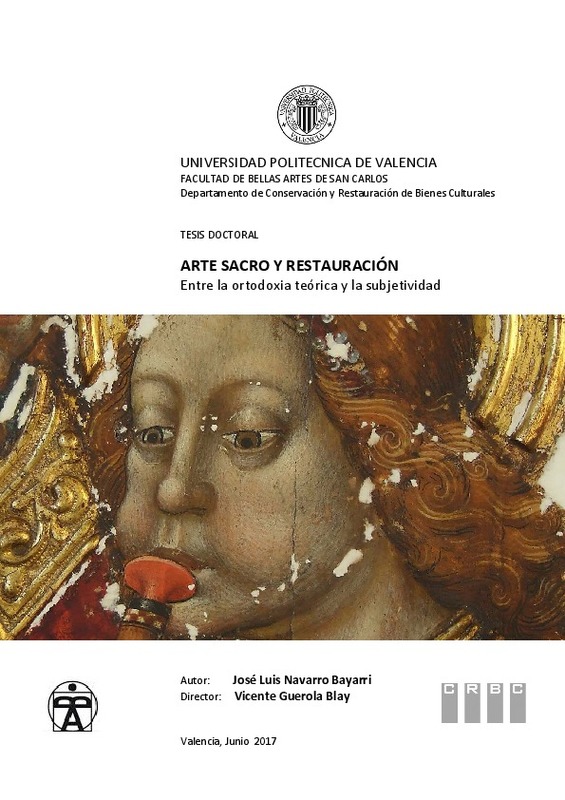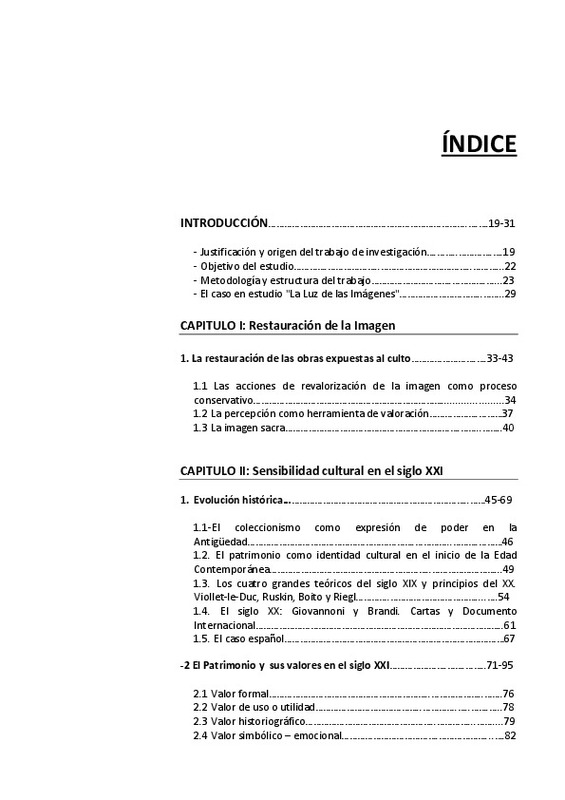- RiuNet repositorio UPV
- :
- Investigación
- :
- Tesis doctorales
- :
- Ver ítem
JavaScript is disabled for your browser. Some features of this site may not work without it.
Buscar en RiuNet
Listar
Mi cuenta
Estadísticas
Ayuda RiuNet
Admin. UPV
Arte Sacro y Restauración: Entre la ortodoxia teórica y la subjetividad
Mostrar el registro sencillo del ítem
Ficheros en el ítem
| dc.contributor.advisor | Guerola Blay, Vicente
|
es_ES |
| dc.contributor.author | Navarro Bayarri, José Luis
|
es_ES |
| dc.date.accessioned | 2017-09-01T07:06:07Z | |
| dc.date.available | 2017-09-01T07:06:07Z | |
| dc.date.created | 2017-07-21 | es_ES |
| dc.date.issued | 2017-09-01 | es_ES |
| dc.identifier.uri | http://hdl.handle.net/10251/86180 | |
| dc.description.abstract | The result of the rendered image obtained after the restoration has been and is a complex and controversial issue. It has been treated throughout history by many specialists, who have built their theories in the shelter of the cultural sensitivity of its time. Especially important for current experts of the Mediterranean area are the premises that Cesare Brandi formulated in the middle of the last century, although, nowadays, the concept of heritage on which he built his treatise has changed. Cultural properties are not only those that are relevant for their historic or artistic quality. The symbolic value of the work of art is a fundamental aspect to take into account also, therefore, the classical theories may not be valid. The current premises say that the authenticity of an artistic property lies in the sum of the values that characterize that object in the present and that, therefore, it is not something that comes because of the past. That is why the terms of the cultural property ceases to be, in some works, the main thing, because not only is restored this aspect. Both values have to be preserved, the immaterial and the material ones. From this perspective, since the subjects bring values, it is essential for the intervention take into account the needs of the users of the works. But this, in the workshops seems to be not accepted. The influence of positivism at the base of the formation of the majority of the technicians and the advances in technology make the intangible information stays relegate to the background. It is not assumed that science provides only part of the information and that it does not have all the answers. You need to search, in the restoration of the lost image, aims to recover the aesthetic experience of those who provide consideration of heritage to that cultural property. For this reason it is essential to judge the problem from the consensus and shared dialogue, which have to be involved both, specialists and users. And in this intersubjective space it is where there are the answers that better they will answer to the horizon of expectations of all the involved parts. To understand how to apply to the praxis all these new current theoretical concepts, there are exhibited thirteen cases of works of sacred art with different problems. The selected works are of religious themes because, in them, the symbolism plays an essential role and makes the critical judgment more complex. | en_EN |
| dc.description.abstract | El resultado de la imagen representada que se obtiene tras la restauración ha sido y es un tema complejo y polémico. Ha sido tratado a lo largo de la historia por numerosos especialistas, que han construido sus teorías al abrigo de la sensibilidad cultural de su época. Especialmente importantes para los técnicos actuales del ámbito mediterráneo son las premisas que enunció Cesare Brandi a mediados del siglo pasado, aunque, hoy en día, el concepto de patrimonio sobre el que edificó su tratado ha cambiado. Los bienes culturales no son sólo aquellos que son relevantes por su calidad artística o histórica. El valor simbólico de la obra es un aspecto fundamental a tener en cuenta también, por ello, las teorías clásicas pueden no resultar válidas. Las premisas actuales dicen que la autenticidad de un bien reside en la suma de los valores que caracterizan a ese objeto en el presente y que, por tanto, no es algo que venga dado del pasado. De ahí que la materia del bien cultural deja de ser, en algunas obras, lo prioritario, porque ya no sólo se restaura esta. Se tienen que conservar tanto los valores materiales como los inmateriales. Desde esta perspectiva, y dado que los sujetos aportan los valores, es imprescindible que en la intervención se tenga muy en cuenta las necesidades de los usuarios de las obras. Pero esto, en los talleres parece no ser aceptado. La influencia del positivismo en la base de la formación de la mayoría de los técnicos y los avances de la tecnología hacen que la información intangible se quede renegada a un segundo plano. No se asume que la ciencia aporta sólo parte de la información y que no tiene todas las respuestas. El objetivo que se tiene que buscar, en la restauración de la imagen perdida, es recuperar la experiencia estética de los que aportan la consideración de patrimonio a ese bien. Por ello es imprescindible enjuiciar el problema desde el consenso y el diálogo compartido, en el que tienen que participar tanto los especialistas como los usuarios. Y en ese espacio intersubjetivo es donde se encuentran las respuestas que mejor responderán al horizonte de expectativas de todas las partes involucradas. Para entender cómo aplicar a la praxis todos estos nuevos conceptos teóricos actuales, se exponen trece casos de obras de carácter sacro con diferente problemática. Las obras seleccionadas son de temática religiosa debido a que en ellas el simbolismo juega un papel esencial y hace que el juicio crítico sea más complejo. | es_ES |
| dc.description.abstract | El resultat de la imatge representada que s'obté després d'una restauració ha sigut i és un tema complex i polèmic. Ha estat tractat al llarg de la història per nombrosos especialistes, que han construït les seues teories a l'empara de la sensibilitat cultural de la seua època. Especialment important per als tècnics actuals de l'àmbit mediterrani són les premisses que va enunciar Cesare Brandi a mitjan segle passat, encara que, avui dia, el concepte de patrimoni sobre el qual va edificar el seu tractat ha canviat. Els béns culturals no són només aquells que són rellevants per la seua qualitat artística o històrica. El valor simbòlic de l'obra és un aspecte fonamental a tenir en compte també, per això, les teories clàssiques poden no resultar vàlides Les premisses actuals diuen que l'autenticitat d'un bé resideix en la suma dels valors que caracteritzen a aquest objecte en el present i que, per tant, no pot vindre establert del passat. Per aquest motiu la matèria del ben cultural deixa de ser, en algunes obres, el prioritari, perquè ja no només s'hi restaura aquesta. S'han de conservar tant els valors materials com els immaterials. Des d'aquesta perspectiva, i atès que els subjectes aporten els valors, és imprescindible que en la intervenció es tinga molt en compte les necessitats dels usuaris de les obres. Però açò als tallers sembla no estar acceptat. La influència del positivisme a la base de la formació de la majoria dels tècnics i els avanços de la tecnologia fan que la informació intangible es quede renegada a un segon pla. No s'assumeix que la ciència aporta sols part de la informació i que no té totes les respostes. L'objectiu que s'ha de buscar, en la restauració de la imatge perduda, és recuperar l'experiència estètica dels quals aporten la consideració de patrimoni a aquest bé. Per això és imprescindible enjudiciar el problema des del consens i el diàleg compartit, en el qual han de participar tant els especialistes com els usuaris. I en aquest espai intersubjetiu és on es troben les respostes que millor respondran a l'horitzó d'expectatives de totes les parts involucrades Per entendre com aplicar a la praxi tots aquests nous conceptes teòrics actuals, s'exposen tretze casos d'obres de caràcter sacre amb diferent problemàtica. Les obres seleccionades són de temàtica religiosa a causa que en elles el simbolisme juga un paper essencial i fa que el judici crític siga més complex. | ca_ES |
| dc.language | Español | es_ES |
| dc.publisher | Universitat Politècnica de València | es_ES |
| dc.rights | Reserva de todos los derechos | es_ES |
| dc.subject | Arte Sacro | es_ES |
| dc.subject | Restauración | es_ES |
| dc.subject | Subjetividad | es_ES |
| dc.subject | Intersubjetividad | es_ES |
| dc.subject | Valores | es_ES |
| dc.subject | Reintegración | es_ES |
| dc.subject | Luz de las imágenes | es_ES |
| dc.subject.classification | PINTURA | es_ES |
| dc.title | Arte Sacro y Restauración: Entre la ortodoxia teórica y la subjetividad | es_ES |
| dc.type | Tesis doctoral | es_ES |
| dc.identifier.doi | 10.4995/Thesis/10251/86180 | es_ES |
| dc.rights.accessRights | Abierto | es_ES |
| dc.contributor.affiliation | Universitat Politècnica de València. Departamento de Conservación y Restauración de Bienes Culturales - Departament de Conservació i Restauració de Béns Culturals | es_ES |
| dc.description.bibliographicCitation | Navarro Bayarri, JL. (2017). Arte Sacro y Restauración: Entre la ortodoxia teórica y la subjetividad [Tesis doctoral]. Universitat Politècnica de València. https://doi.org/10.4995/Thesis/10251/86180 | es_ES |
| dc.description.accrualMethod | TESIS | es_ES |
| dc.type.version | info:eu-repo/semantics/acceptedVersion | es_ES |
| dc.relation.pasarela | TESIS\6682 | es_ES |
Este ítem aparece en la(s) siguiente(s) colección(ones)
-
Tesis doctorales [5389]








![MS Word file [Word]](/themes/UPV/images/msword.png)

